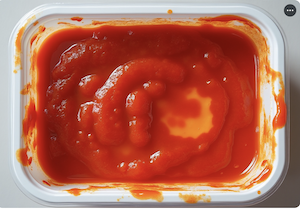Don’t you hate it when a perfectly good plastic food container looks completely ruined?
Tomatoes are not only a staple in many dishes but also a rich source of lycopene, a carotenoid known for its antioxidant properties. Lycopene isn’t just good for your health, potentially reducing the risk of strokes and certain cancers; it’s also what gives tomatoes, pink grapefruits, and red cabbage their vibrant colors. However, this beneficial compound has a downside – it’s notoriously tough to clean off surfaces due to its water-repellent nature.
So don’t let tomato stains ruin your kitchenware. With these simple, eco-friendly solutions using vinegar and baking soda, you can keep your containers looking new. Remember, a little bit of these household heroes goes a long way in maintaining a spotless kitchen. So next time you’re dealing with a stubborn tomato stain, reach for the vinegar or baking soda before anything else!
The Stain-Fighting Strategy
If you’ve ever tried scrubbing tomato sauce out of a plastic container without much success, you’re not alone. Here’s where common household items come to the rescue:
- Vinegar Solution:
- Rinse your container to remove any loose food particles.
- Mix equal parts of vinegar (white, apple cider, or cleaning vinegar) with water.
- Fill your stained container with this mixture and let it sit for up to 24 hours.
- After soaking, pour out the solution, and wash the container with soap and water. The stain should now be significantly lighter or completely gone.
- Baking Soda Paste:
- Create a paste by mixing baking soda with a little water. Add a drop or two of dish soap for extra cleaning power.
- Apply this paste to the stained areas inside your container.
- Let it sit for about 30 minutes. The baking soda will help lift the stain.
- Scrub gently if necessary, then rinse with soap and water.
Preventive Measures
To avoid future staining, consider storing tomato-based foods in glass or Pyrex containers rather than plastic. These materials are less likely to absorb and retain stains.
Why This Works
Lycopene’s hydrophobic nature makes it resistant to regular cleaning methods. Vinegar, with its acidic properties, breaks down the stain, while baking soda acts as a gentle abrasive and neutralizes odors, making it easier to scrub away the remnants.
